The local lack of water and impoverished soil prompted the garden to join a participatory project with a network of permaculturists, experimentally creating three food forests of Mediterranean species through dryland farming, in which soil regeneration and water conservation techniques combine with the conservation of fig and pomegranate agricultural biodiversity.
The history of this garden dates back to around 1610, when Zanobi di Andrea Lapi commissioned the building. It was enlarged in the 18th century by its new owners, the Capponi family, who also redesigned the garden layout. After several decades of abandonment, in 1896 the complex was purchased by Princess Jeanne Catherine Ghyka. An artist of great sensibility, she created a garden characterized by a highly original water parterre, consisting of four rectangular pools bordered by boxwood hedges and ending in a hemicycle of cypress trees shaped into an arch. Villa Gamberaia became one of Italy’s most iconic gardens, the handiwork of a woman who, to this day, remains shrouded in an aura of mystery. She was assisted by gardener Martino Porcinai, father of Pietro, who became Italy’s pre-eminent 20th-century landscape architect. The gate at the exedra-shaped entrance on Via del Rossellino opens onto a boulevard of cypresses, forming a visual corridor that leads the visitor’s gaze towards the villa. Two arches abutting the house connect the first floor to the chapel. A long, straight “bowling-green” lawn ends to the north in a nymphaeum, and to the south with broad views out over the Arno valley, with access to the Cabinet de Rocaille, an extraordinary baroque invention of scenographic staircases connecting the selvatico and “lemon house”, which during wintertime houses a major collection of citrus fruits.
Highlights
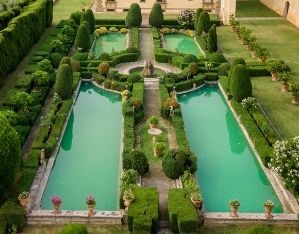
The Water Parterre
The brainchild of the owner and her personal creation, the water parterre is the the villa’s hallmark feature. Reprising a theme from Villa Lante in Bagnaia, four bodies of water were installed to replace the 18th-century
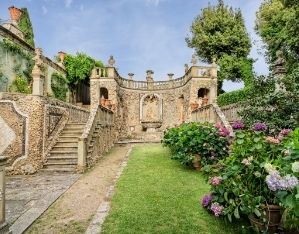
The "Cabinet de Rocaille"
The walls of this long, narrow, enclosed space are richly decorated with niches and terracotta statues, shell mosaics and marble. Two double flights of stairs on its longer sides lead to the selvatico and the Limonaia garden.
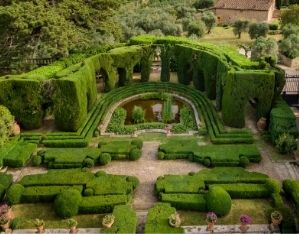
The Nymphaeum
Dominated by tall cypress trees and enclosed within a wall with stone mosaic-decorated benches, this space was perhaps originally created for musical performances. The divinity in the niche carved into the hillside, probably Dionysus, surrounded by shepherds musicians and animals in procession, renders this place rather enigmatic.
Find out more
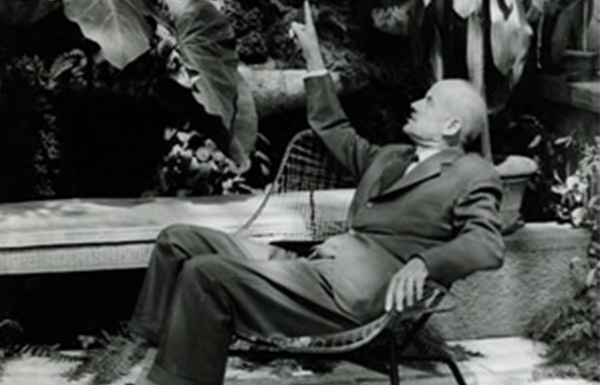
Gardens of the twentieth century
A Florentine architect and landscape architect, he is the son of Martino, who was the gardener of Gamberaia from 1902 to 1916. He completed his apprenticeship abroad and in nurseries (Martino Bianchi’s in Pistoia), coming into contact with the great masters of garden architecture.
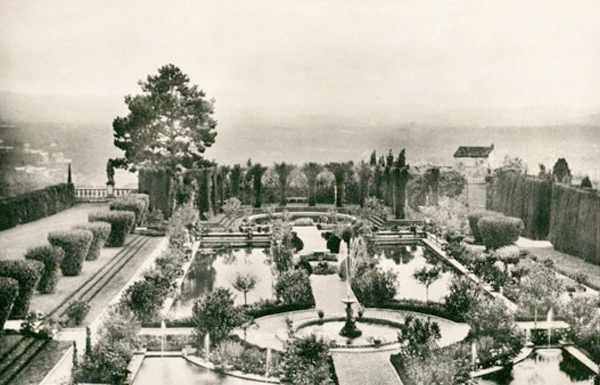
GREAT WOMEN, GREAT GARDENS
Of Romanian origin, daughter of Colonel Peter Keshko and Princess Pulchérie Stuzdza, Catherine is a prominent figure not only because of her family origins (she was the sister of Queen Natalia of Serbia) but also because of the cultural and artistic environment she loves to frequent.
 Villa Gamberaia
Contacts
Villa Gamberaia
Contacts
Contacts
Telephone:- +39 055 697205
- +39 3472386326 (visite domenicali o giorni festivi)
Fax: +39 055 0168691
Address
Via del Rossellino, 72
50135, Settignano (FI)
 Villa Gamberaia
Opening times and prices
Villa Gamberaia
Opening times and prices
Opening hours
The gardens are open:
- on weekdays from 9:00 a.m. to 7:00 p.m. (last entry at 6:00 p.m.)
- Sundays from 9.00 a.m. to 6.00 p.m. (last entrance at 5.00 p.m.).
The Villa:
- from Tuesday to Saturday from 9:00 a.m. to 12:00 p.m. Individuals and groups of less than 10 people can visit the inside of the villa, by appointment.
Sometimes the gardens may be closed to the public. We recommend that you contact the Gardens to be sure that you can visit on a particular date.
Pricing
Visit to the Gardens:
- € 15,00 per person
- € 10,00 for students
- € 12,00 for FAI members
- € 20,00 per person, ordinary and students.
- Visits to the interior of the Villa are reserved for groups of at least 10 people, by appointment.
 Villa Gamberaia
How to get there
Villa Gamberaia
How to get there
Address
Via del Rossellino, 72
50135, Settignano (FI)
Latitude: 43.7799904
Longitude: 11.3269591
How to arrive by road
Follow the signs for Via Gabriele D’Annunzio and continue towards Settignano. It is advisable to enter Piazza Niccolò Tommaseo in Settignano in your navigator as your destination and, once you have reached it, proceed following the road signs for Villa Gamberaia.
How to arrive by bus
From Piazza San Marco in Florence you can take bus number 10 to the terminus in Settignano. From the stop, after about 10 minutes on foot, you will reach the Villa (following the signs) in via del Rossellino 72.
 Villa Gamberaia
Services/Accessibility
Villa Gamberaia
Services/Accessibility
Services
Some of the residences and buildings of Villa Gamberaia, have been restored and transformed into guest houses and fully furnished apartments, made available to guests for short stays or longer stays. For more information on types and costs, consult the .
 Villa Gamberaia
Private events
Villa Gamberaia
Private events
The rooms of the main body of Villa Gamberaia and its gardens are available to guests for the organization of wedding receptions, banquets, fashion shows, team building activities and other events.
 Villa Gamberaia
Itineraries
Villa Gamberaia
Itineraries
You could find the garden in these itineraries
 Favorite saving result
Favorite saving result
 Warning!
Warning!
You've have to sign up or sign in to add this element to your favorites.
